

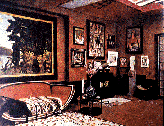 Art Deco is a decorative style that is essentially an extension of the French
Art Nouveau and English Aesthetic styles, but also includes elements of Arts and
Crafts form. Some historians claim that because of its eclectic borrowing from
so many sources, it should not be identified as a distinct style. Yet it has enjoyed
recurrent popularity, and has contributed to later stylistic developments. The
term Art Deco is used to describe a design style that originates around World
War I, and runs through to World War II (c. 1915-1945).
Art Deco is a decorative style that is essentially an extension of the French
Art Nouveau and English Aesthetic styles, but also includes elements of Arts and
Crafts form. Some historians claim that because of its eclectic borrowing from
so many sources, it should not be identified as a distinct style. Yet it has enjoyed
recurrent popularity, and has contributed to later stylistic developments. The
term Art Deco is used to describe a design style that originates around World
War I, and runs through to World War II (c. 1915-1945).
The style emphasizes surface embellishment, drawing heavily on the colors and styles of some of the early modern art movements, from Impressionism through Cubism. Like many of the modern art styles, it was inspired by Chinese and Japanese art, both of which were popular during this period.
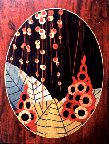 Art Deco furnishings frequently used marquetry, enamelling and other techniques
to create surface interest. During the 1920's vivid color was often used. Both
furniture and textiles tended to use decorative designs that exhibited a strong
painterly quality reminiscent of Impressionist, and post-Impressionist, Fauve,
and Cubist techniques. The forms of furniture and interiors combined sleek curves
with angularity, the forms often quoting earlier decorative styles in a simplified
form.
Art Deco furnishings frequently used marquetry, enamelling and other techniques
to create surface interest. During the 1920's vivid color was often used. Both
furniture and textiles tended to use decorative designs that exhibited a strong
painterly quality reminiscent of Impressionist, and post-Impressionist, Fauve,
and Cubist techniques. The forms of furniture and interiors combined sleek curves
with angularity, the forms often quoting earlier decorative styles in a simplified
form.
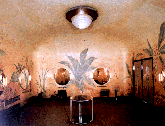 In the 1930's the color palette became more subdued with white, black, and metallic
surfaces combined with softer hues. Decorative design in textiles continued
to quote from modern art, with Cubism appearing as a more apparent influence,
in addition to other styles. The characteristic forms, a combination of smooth
curves and angles, continued to be the dominant feature of the style. The style
came to be associated with a high technology, futurist view of American culture
in an age when the romance of air travel was at its peak. The idea of streamlining
based on aerodynamics became a feature of design used in everything from architecture
to appliances. Classic examples of
Art
Deco architecture include the
Chrysler Building and
Rockefeller Center in
New York City, and the
Miami Beach waterfront.
The graphic designer Erte created a characteristic Art Deco style in
illustration and decoration.
In the 1930's the color palette became more subdued with white, black, and metallic
surfaces combined with softer hues. Decorative design in textiles continued
to quote from modern art, with Cubism appearing as a more apparent influence,
in addition to other styles. The characteristic forms, a combination of smooth
curves and angles, continued to be the dominant feature of the style. The style
came to be associated with a high technology, futurist view of American culture
in an age when the romance of air travel was at its peak. The idea of streamlining
based on aerodynamics became a feature of design used in everything from architecture
to appliances. Classic examples of
Art
Deco architecture include the
Chrysler Building and
Rockefeller Center in
New York City, and the
Miami Beach waterfront.
The graphic designer Erte created a characteristic Art Deco style in
illustration and decoration.
Sullivan's influence can be seen in Wright's concern with the relationship of a building to its environment:

Wright's designs sought to demonstrate this unity of site and purpose. He spoke of the need to "develop an organic unity of planning, structure, materials, and site." His work was to influence the development of European modernism, though this occurred mainly through the publication of Wrights designs, and his many writings, since relatively few of his designs were actually built before the 1930's.
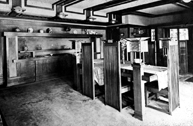 Wright was a contributor to the American Arts and Crafts style, although his
designs were uniquely his own. His ideas were also in part shaped by his experiences
in Japan, where he constructed
the Imperial Hotel in Tokyo in 1922. (The hotel was demolished in 1968,
but a section of the facade and lobby was reconstructed in a Tokyo park). The
Japanese aesthetic, which stressed the interrelationship of landscape and architecture,
and the planning of landscape, was of great importance to Wright's work. Specific
forms, such as the asymmetrical geometric forms of the simple Japanese domestic
interior, and the deep overhanging eves of Japanese roofs, became characteristic
features of Wright's designs.
Wright was a contributor to the American Arts and Crafts style, although his
designs were uniquely his own. His ideas were also in part shaped by his experiences
in Japan, where he constructed
the Imperial Hotel in Tokyo in 1922. (The hotel was demolished in 1968,
but a section of the facade and lobby was reconstructed in a Tokyo park). The
Japanese aesthetic, which stressed the interrelationship of landscape and architecture,
and the planning of landscape, was of great importance to Wright's work. Specific
forms, such as the asymmetrical geometric forms of the simple Japanese domestic
interior, and the deep overhanging eves of Japanese roofs, became characteristic
features of Wright's designs.
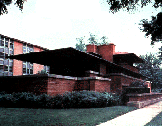
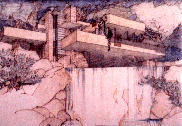 Most of Wright's early designs
were for private homes; the Robie house, built in 1909, is one example
of his early style, which contained features such as dominant horizontal lines,
deep eaves, asymmetrical forms, and the innovative use of the cantilever to
support an overhanging roof. This link will take you to more pictures of the
Robie House and
other sites. These were all features characteristic of his work. Probably the
best known of his private residence designs is
Fallingwater
at Bear Run, near Uniontown, PA. This house actually projects over a waterfall,
supported by cantilevers, and is considered to be one of the finest examples
of Wrights work. It is a brilliant example of incorporating a structure into
its site. This link
provides a video tour of the site.
Most of Wright's early designs
were for private homes; the Robie house, built in 1909, is one example
of his early style, which contained features such as dominant horizontal lines,
deep eaves, asymmetrical forms, and the innovative use of the cantilever to
support an overhanging roof. This link will take you to more pictures of the
Robie House and
other sites. These were all features characteristic of his work. Probably the
best known of his private residence designs is
Fallingwater
at Bear Run, near Uniontown, PA. This house actually projects over a waterfall,
supported by cantilevers, and is considered to be one of the finest examples
of Wrights work. It is a brilliant example of incorporating a structure into
its site. This link
provides a video tour of the site.
 One of his most important major public commissions was built in 1939 for
the
Johnson Wax Company in Racine, Wisconsin. This building incorporated
many design features originally developed in his earlier work. The
Guggenheim Museum, with its spiral shell-like form, was completed in 1957.
It is the best known of his later works that explored the use of circular forms.
One of his most important major public commissions was built in 1939 for
the
Johnson Wax Company in Racine, Wisconsin. This building incorporated
many design features originally developed in his earlier work. The
Guggenheim Museum, with its spiral shell-like form, was completed in 1957.
It is the best known of his later works that explored the use of circular forms.
This link will take you to a very complete site on Wrights work.
 |